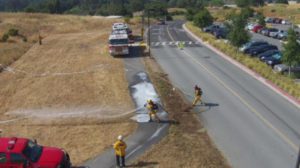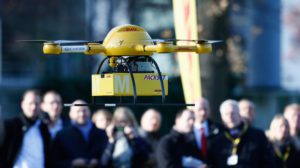Real Estate drone photography creates a level of visual intrigue that is hard to match, and in a way that is more affordable than you might think.
Technological advances have made it efficient and cost effective to take real estate drone photography and videos from drones, aka Unmanned Aerial Systems (UAS or UAV or Drone). Real estate professionals working with residential, commercial and land parcels can all benefit from the images and information obtained from using UAS technology. This imagery is an incredible tool for potential homeowners moving to a different city, buying a second home, or trying to streamline the research process necessary to buy a new home.
Many commercial properties or large parcels of land do not lend themselves well to traditional photography. Other UAS applications in real estate include general property due diligence, insurance inspections, appraisals, building management, and heat-loss imaging using thermal cameras.
To date, Goldman Sachs reports Real Estate in the top ten uses of commercial UASs (real estate represents 26 percent). You might be asking yourself if using drones for real estate photography is viable even necessary for you to stay competitive or if it’s just a flash in the pan. Whatever you decide, drones are shaping up to be the next evolution in real estate marketing.
Here are a few things to think about if you’re either considering or already using drones for your real estate photography.
Drones have more uses than you realize
For real estate agents, drone photography can show potential buyers a variety of details, including:
- Encompassing aerial views of the entire property and land
- Confirming condition of the roof and other property features that are difficult to access
- What the drive home or the kids walk to school looks like
- The neighborhood and surrounding area, including the home’s proximity to amenities
- Civic developments or local improvement districts (LIDs) that the buyer’s property taxes might contribute to
Drones make elevated imagery affordable
Drones can significantly cut the cost of shooting elevated imagery. Whether you decide to buy your own drone from 1UP or contract with 1UP for Real Estate drone services there are viable models that start at a few hundred dollars, and camera attachments are similarly moderately priced and enable you to use their aerial footage on many more listings, regardless of price range.
Depending on your equipment setup, or services required, drones can shoot stills, video or both. You can edit and share the video using a number of tools and without extensive experience or expertise.
There are strict rules to follow
The idea of drones buzzing around your head you may have seen or heard them while you’re out and about or taking illicit footage of you through your window is disturbing and not lost on the FAA. The stringent guidelines of operations may be found in the official Part 107 of Title 14 of the Code of Federal Regulation (14 CFR) if you want to dive into the nitty gritty of the regulations. At 1UP we adhere closely to these rules and definitely use common sense as ambassadors to the nascent industry.


